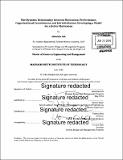The dynamic relationship between motivation, performance, organizational commitment, and job satisfaction: developing a model for a better motivation
Author(s)
Ișik, Abdullah
DownloadFull printable version (4.516Mb)
Other Contributors
Massachusetts Institute of Technology. Engineering Systems Division.
Advisor
Steven Spear.
Terms of use
Metadata
Show full item recordAbstract
This study explores the dynamic relationship among motivation, work performance, organizational commitment, and job satisfaction as well as drivers of each of them. Main goal of this study is to understand what factors motivates people better and increase their (i) work performance, (ii) organizational commitment, and (iii) job satisfaction. For this purpose, this study is focused on the factors influencing motivation, work performance, organizational commitment, and job satisfaction. Although the previous research was abundant, there was no research directly focused on four of them at the same time. Moreover, there wasn't a single model to tell about how to increase the level of those focused four variables at the same time. This study (i) combined the empirical data of the related literature to create a model, (ii) then simplified the combined model to create a simple testable literature model, and (iii) tested the simplified literature model. A certain type of section in Organization X was focused to test the model. The actual model-in-use created after conducting interviews with the members of that specific type of section. For the final step, the differences between simplified literature model and actual model-in-use was discussed and recommendations were given. A total of ten independent variables were determined after analysis of interview data. The nine of the independent variables in the actual model-in-use was matched with the independent variables of the simplified literature model. The actual model-in-use has a new independent variable. As the last step of the research, recommendations were formed according to interview data or personal experience; to close the gap.
Description
Thesis: S.M. in Engineering and Management, Massachusetts Institute of Technology, School of Engineering, System Design and Management Program, Engineering and Management Program, 2016. Cataloged from PDF version of thesis. Includes bibliographical references (pages 67-70).
Date issued
2016Department
Massachusetts Institute of Technology. Engineering and Management Program; System Design and Management Program.Publisher
Massachusetts Institute of Technology
Keywords
Engineering and Management Program., System Design and Management Program., Engineering Systems Division.